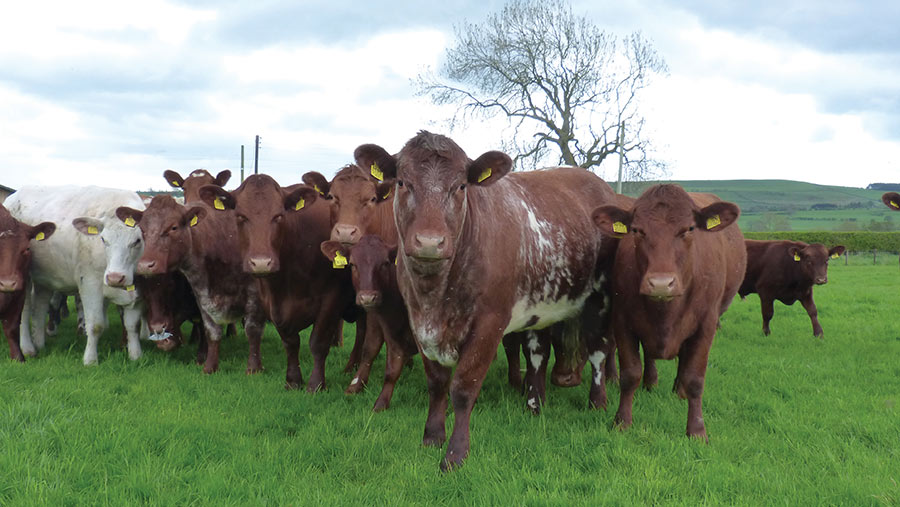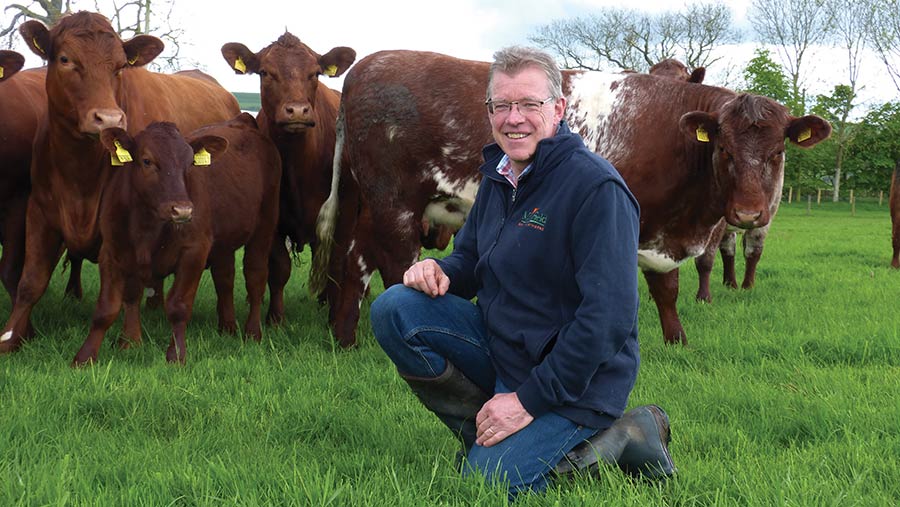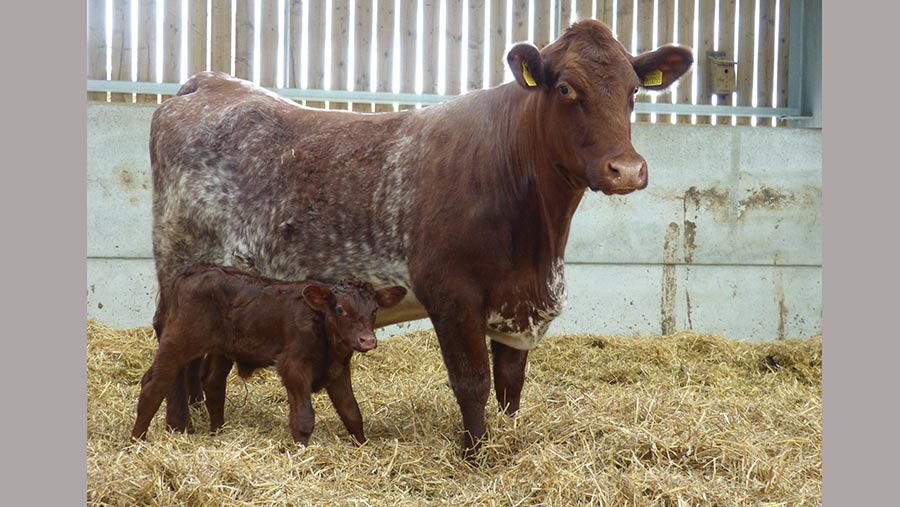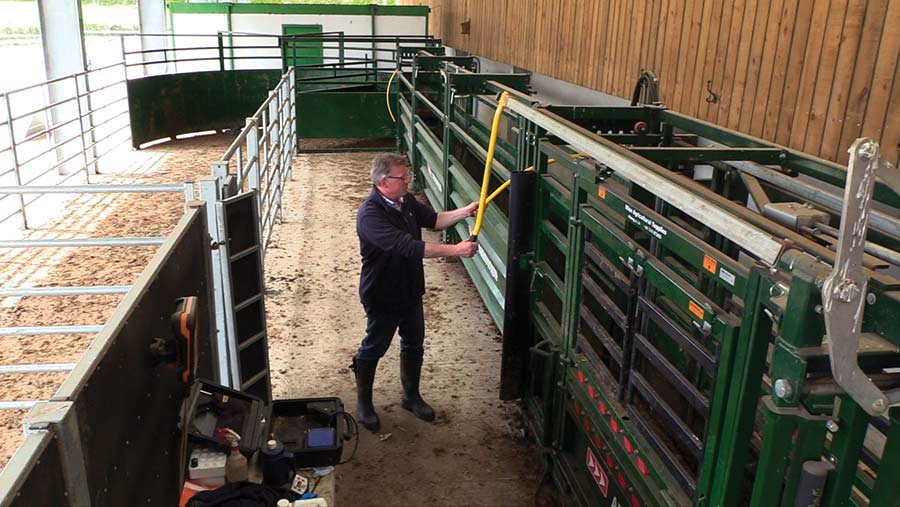Video: How Shorthorn forage system hits 500kg bulling weights
 © MAG/Michael Priestley
© MAG/Michael Priestley Trawling the globe for elite commercial sires and flushing easy-fleshing females from forage-based systems has helped a pedigree herd expand while consistently bulling heifers at 14-15 months old.
Dutch veterinary surgeon Gerard te Lintelo and his wife, Joanne, of Mayfield Beef Shorthorns, Wolsingham, County Durham, calve their heifers at 24 months.
See also: Step-by-step guide to carrying out IVF on cows
The Weardale-based herd has recorded average daily liveweight gains of 1.12kg a head a day to 400 days in its heifers, and boasts several 33-34-month-old females with their second calf at foot.
But Gerard stresses that growth and performance are based on forage-reared genetics, underpinned by productive grass and clover leys and the 45ha (111 acres) of multispecies swards on the farm.
Farm facts: Mayfield Beef Shorthorns
- 70 suckler cows, mostly pedigree Shorthorn
- 239ha, of which about 100ha is farmed in hand
- 200ha of grassland, of which about 25ha is in arable rotation
- Growing oats and barley
- 45ha of multispecies leys
- 39ha of woodland and watercourse margin
- 20 Angus-cross and Shorthorn recipients
- Expecting to calve 75 cows next year
- Closed flock of 60 Teeswater breeding ewes

© MAG/Michael Priestley
Getting started
Gerard qualified as a vet in the Netherlands in 1997 and moved to the UK in 1999, working in small animal practice before specialising in surgery and starting his own practice – Wear Referrals – in 2005.
Wear Referrals grew into one of the UK’s leading pet surgeries, employing 130 staff. He sold the business in 2018.
Gerard’s veterinary background has been a key part of the herd’s progress.
Advanced breeding techniques have been used to multiply the best females in the herd, with the aim to be a Shorthorn herd that can provide a bull for every type of customer.
He believes genetics based on low-cost, forage-based performance and easy calving will be sought after in the years ahead. This is the justification he has for investing heavily in a pedigree cattle operation.
He aims to get heifers to 60% of mature weight by 15 months, which can be 440kg for a cow that will be 750kg, or 520kg for a cow that will grow to be about 865kg.
“There is a huge variety within the Shorthorn breed and we aim to provide something for everyone,” he explains. “We have larger-statured cattle and smaller, mature sizes.
“In general, I am trying to moderate cow size to be nearer 750kg rather than 850kg, but everybody has a cow type that works for them.”
In the video below, Gerard explains the setup on his farm.
Average growth and weights of Mayfield youngstock since 2016 |
||||
|
200-day weight (kg) |
Daily liveweight gain at 200 days (kg) |
400-day weight (kg) |
Daily liveweight gain at 400 days (kg) |
|
|
Heifers |
290 |
1.3 |
470 |
1.12 |
|
Bulls |
327 |
1.44 |
570 |
1.2 |
Eight key factors for fast-growing heifers

© MAG/Michael Priestley
1. Multiplying elite females
- The herd is based on five in-calf heifers bought in 2016 for an average of £6,000 a head: three Chapelton heifers and two Upsall heifers. These were from proven female families with good growth estimated breeding values (EBVs) from forage, type and udder structure.
- Multiple ovulation embryo transfer (Moet) and in-vitro fertilisation (IVF) have been used to grow the herd. Pure and Angus cross Shorthorn heifers used as recipients to ensure performance is genuine beef performance, not a milky dairy cow.
- IVF costs £150-£200/viable embryo produced, with a pregnancy rate of about 60% on fresh transfers and 40% on frozen embryos. Each calf born via conventional embryo transfer costs about £1,200 at a 50% rearing success rate. Importing embryos costs about £500 an embryo.
2. State-of-the-art sheds
- As well as a herd health and vaccination plan, the farm has high-welfare sheds built in 2021, designed to be safe for cattle and people.
- Two 35x48m cattle sheds can each be split into eight pens for in-calf cows, calving cows and youngstock.
- Tipping troughs, weaning gates, self-locking yokes, adjustable windbreakers, swing brushes, and deep bedded straw from the arable enterprise, make for a comfortable shed in which heifers thrive.
3. Proven forage-based bulls
- Genetic progress and foraging ability are ensured by using bulls from forage-reared systems in Australia and Canada.
- Breeding values are scrutinised for 200-day weight (milk), 400-day weight (early maturity), mature cow size (not too high), marbling, calving ease direct and indirect, and scrotal size.
- Crooked Post Stockman, Hill Haven Firestorm and Sprys All Gold embryos were imported from Canada. Royalla Rembrandt, Sprys Patent Ace and Muridale Thermal Energy embryos were imported from Australia.
- Only bulls with performance from 150 or more calves and strong accuracy figures are selected.

© MAG/Michael Priestley
4. Low-stress handling
- A handling system design based on Dr Temple Grandin’s principles and a quiet, ergonomic crush allow weight collection, vaccination and TB testing to be a safe, one-person job if needs be.
- Growth rates plummet when cattle are handled, so making the process calm, quiet and low-stress means heifers are more settled and their growth check is lessened.
5. Easy weaning
- Calves are weaned inside via a creep gate. The creep area provides a small amount of creep and high-quality big bale silage, which is better than the cow silage.
- Stage one, lasting one week, uses the creep gate to allow calves access to the best silage and a small amount of creep feed.
- Stage two sees the gate shut and calves and cows penned either side of a partition rail inside for a further week before calves transfer to another shed.
- A 50:50 mix of home-grown oats and a heifer rearing pellet is built up to a restricted intake of 1.5kg a day.
- Creep is fed for four to six weeks before and after weaning date (at about 200 days). Total intake is about 100kg, which is for rumen transition and stress management.
6. Good-quality forage
- The system is based on harvesting silage for quality rather than bulk, and extensive use of red clover, white clover and herbal leys. Dedicated silage fields have two or three cuts and some grazing fields receive a first cut before grazing.
- Dry cow silage is about 11% crude protein (CP) and 10MJ/kg metabolisable energy (ME) while silage for young calves and lactating cows is 13% CP and 11-12MJ/kg ME.
- Gerard has calculated that one big round bale of red clover silage has the energy and protein content of nine bags of calf feed.
7. Pelvic measuring
- Monitoring pelvic dimensions helps minimise calving issues by rejecting and fattening the heifers with the smallest pelvises.
- This has been done for four years. The minimum cut-off is 160 sq cm (standardised to 365 days of age).
- Reject numbers have fallen each year and no heifers were rejected for pelvis size this spring.
8. Calving ease
- Average birth weights for bull calves (41kg) and heifer calves (39kg) are low.
- Calving assistance is artificially high, at 5%, because high-value embryo calves are given a precautionary pull.
- Any females with calving problems are recorded and rejected.